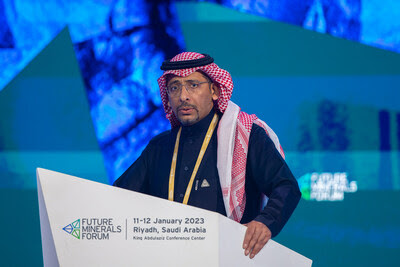وزير الصناعة والثروة المعدنية مخاطباً المشاركين في المؤتمر: أنقل لكم حرص قيادة المملكة على نجاح المؤتمر وتحقيقه للأهداف المنشودة للمنطقة والعالم
الرياض، المملكة العربية السعودية, 11 يناير / كانون الثاني 2023/PRNewswire/ — انطلقت صباح اليوم في الرياض فعاليات النسخة الثانية من مؤتمر التعدين الذي ينعقد تحت رعاية خادم الحرمين الشريفين، الملك سلمان بن عبد العزيز آل سعود، حفظه الله، بهدف تطوير الحوار حول مستقبل المعادن والاستثمار في التعدين، والتعاون في هذا المجال عبر المنطقة الممتدة من إفريقيا إلى غرب ووسط آسيا.

وفي كلمته في افتتاح المؤتمر، رحب معالي وزير الصناعة والثروة المعدنية، الأستاذ بندر الخريف، بالمشاركين في جلسات وفعاليات المؤتمر، قائلا: “يشرفني أن أفتتح اليوم أعمال هذه القمة نيابة عن مولاي خادم الحرمين الشريفين -حفظه الله – ، وأنقل لكم حرص قيادة المملكة، ممثلة في مولاي خادم الحرمين الشريفين، وسمو سيدي ولي العهد رئيس مجلس الوزراء -حفظهم الله – على نجاح المؤتمر وتحقيقه للأهداف المنشودة للمنطقة والعالم، مثمنًا لكم الحضور والمشاركة الفاعلة في هذه النسخة من مؤتمر التعدين الدولي”.
وأشار معالي المهندس بندر الخريف، في كلمته، إلى أن النسخة الأولى من المؤتمر والتي عقدت في يناير 2022، كانت تهدف إلى التعريف بالإمكانات التعدينية للمملكة ودول المنطقة الناشئة، والتي يمكنها أن تلعب دورًا مُهمًا في تلبية احتياجات المستقبل من المعادن، مشيرًا إلى أن النسخة الثانية التي نعلن عنها اليوم ستناقش مجموعة من الموضوعات الملحة، من بينها تنمية المنطقة وزيادة مساهمتها في سلاسل القيمة والإمداد للمعادن الحرجة، وتعزيز التعدين المسؤول والمستدام، والاستفادة القصوى من الثروات المعدنية في منطقة التعدين الناشئة التي تمتد من أفريقيا حتى غرب ووسط آسيا، وتطوير هذه المنطقة لتصبح مركزا متكاملاً لإنتاج المعادن الخضراء، بالإضافة إلى مناقشة تنمية التعاون الدولي لإنشاء مراكز تميز في المنطقة لزيادة مساهمتها في إمداد معادن المستقبل. 
وأوضح أن الإقبال الكبير لحضور فعاليات المؤتمر من المختصين والمهتمين بشؤون التعدين، حيث يشارك، في نسخة المؤتمر الثانية أكثر من 12000 مشارك من 130 دولة و200 متحدث، يدل على أن مجتمع التعدين يدرك مستوى التحديات، كما يعني أن المملكة نجحت في بلورة دورها المهم والكبير فيما يتعلق بقطاع التعدين في المنطقة، وإطلاق الحوار البناء بين ذوي العلاقة بالقطاع، وتحقيق التعاون المثمر بين الدول في هذا المجال.
وأشار إلى أنه تم عقد اجتماع الطاولة المستديرة الثاني للوزراء المعنيين بشؤون التعدين أمس للتركيز على المنطقة التعدينية الناشئة الممتدة من أفريقيا إلى غرب ووسط آسيا، والتي تتوفر لديها إمكانات وقدرات تعدينية واعدة تمكنها من سد الفجوة المتوقعة على الطلب في المستقبل.
وتطرق معالي وزير الصناعة والثروة المعدنية، في كلمته، إلى الحديث عن جهود المملكة في مجال التعدين، قائلا إنه في إطار رؤية “المملكة 2030” وُضعت تصورات وبرامج لتطوير قطاع التعدين ليُصبح الركيزة الثالثة للصناعة، وأنجزنا مراجعةً شاملةً وحدثنا نظام الاستثمار التعديني، الذي يشكّل البنية التحتية النظامية للقطاع، ويوفر بيئةً واضحة وشفافة ومُيسرةً للمستثمرين في قطاع التعدين، مشيرا إلى أنه تم بناء مدينة صناعية كاملة لمعالجة الألمنيوم من المواد الخام والبوكسيت وصولا إلى المنتجات ذات القيمة المضافة النهائية المستخدمة في صناعة السيارات وتغليف المواد الغذائية.
وفي ختام كلمته دعا معالي وزير الصناعة والثروة المعدنية، الأستاذ بندر الخريف، المشاركين ليكون لهم صوت واحد فيما يتعلق بالحاجة إلى العمل على تأمين مستقبل سلاسل الإمداد للمعادن لتحقيق الانتقال العالمي للطاقة الخضراء والتنمية الاقتصادية الإقليمية في قطاع التعدين والمعادن، قائلا: “ لتحقيق ذلك، يجب أن نبني الثقة ونحافظ عليها… يجب أن نثبت أننا شريك موثوق به… والأهم من ذلك، يجب أن تعكس أفعالنا ما نقوله… دعونا نستفيد إلى أقصى حد من فرصتنا لتطوير منطقتنا… هذا التطور الذي من شأنه تحسين الكوكب، وتحسين حياة الجميع”.
وقد تلى كلمة معالي الوزير انطلاق جلسات المؤتمر التي يشارك فيها وزراء وممثلو حكومات عدد من الدول، إضافة إلى مشاركة قادة الاستثمار، ورؤساء كبرى شركات التعدين، وخبراء ومختصين تقنيين في هذا المجال.
ويشهد المؤتمر، على مدار يومين، مناقشة عدد من الموضوعات الملحة في قطاع التعدين، والتي تشمل محور بحث التطورات الاقتصادية والبيئية العالمية التي تؤثر على صناعة المعادن في المنطقة، ومحور الممارسات البيئية والاجتماعية من حيث المنافسة وتكافؤ الفرص عبر سلسلة القيمة لتحقيق الازدهار الاقتصادي، والمحور المتعلق بدور المملكة وريادتها على مستوى العالم في إمدادات الطاقة المتجددة والتوقعات الخاصة بذلك خلال الفترة من 5 إلى 10 سنوات. وهناك المحور الخاص بالشكل الذي ستكون عليه شركة تعدين المستقبل، ومحور التطابق بين العرض العالمي والطلب ودور المنطقة في سد فجوة العرض والطلب على المعادن.
وهذا بالإضافة إلى تخصيص منطقة لعرض أحدث تقنيات التعدين الحالية والمستقبلية، ومنطقة معارض خارجية، ومنطقة مخصصة لعرض الفرص الاستثمارية في مناطق أفريقيا وغرب ووسط آسيا، باعتبارها مناطق تعدينية واعدة قادرة على المساهمة في سد فجوات الطلب المستقبلي على المعادن، فضلا عن منطقة توقيع اتفاقيات الشراكة ومذكرات التعاون، والجناح السعودي الذي يجري تنظيمه تحت مظلة مبادرة “استثمر في السعودية”، ويضم العديد من الهيئات والجهات الحكومية لتقديم المعلومات حول أبرز مستجدات الفرص الاستثمارية في المملكة.
صورة: https://mma.prnewswire.com/
صورة: https://mma.prnewswire.com/

